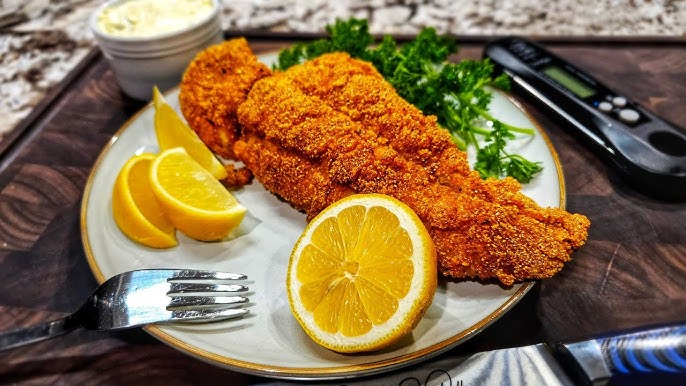Catfish Frying Recipe: Fried catfish is one of those dishes that feels like comfort food wrapped in golden, crispy goodness. Whether you grew up in the South or you’re just someone who loves a good fried meal, catfish brings people together around the table. This recipe is not just about frying fish—it’s about creating a flavor-packed experience that’s crunchy on the outside, tender on the inside, and unforgettable with every bite.
In this guide, you’ll learn everything you need to know, from selecting the right ingredients to frying techniques that guarantee perfect results. By the end, you’ll not only know how to fry catfish like a pro, but you’ll also have insider tips on making it taste authentic and mouthwatering. Let’s get cooking!
Why Fried Catfish is a Southern Classic
When you think about Southern cooking, fried catfish almost always makes the list. It’s more than just a dish—it’s a tradition. Generations of families have gathered for fish fries, often outdoors, where the smell of sizzling fish in hot oil fills the air. Catfish is abundant in rivers across the South, which made it a natural choice for families looking for an affordable and delicious protein.
But it’s not just about availability—it’s about flavor. Catfish has a mild, slightly sweet taste that pairs beautifully with cornmeal-based coatings. Unlike stronger fish like salmon or mackerel, catfish soaks up seasonings and delivers a satisfying crunch when fried. That’s why it’s a favorite at backyard gatherings, church picnics, and family dinners.
Eating fried catfish is more than filling your belly; it’s a cultural experience. From Louisiana Cajun seasonings to Mississippi-style hush puppies on the side, every region has its own take on this timeless dish.
Health Benefits and Nutritional Value
While fried food often gets a bad rap, catfish actually has some surprising health benefits. It’s a lean source of protein, which means it helps build muscle and keeps you full without being overly fatty. It’s also packed with omega-3 fatty acids that support heart and brain health.
A 3.5-ounce serving of catfish provides about:
- 105 calories
- 20 grams of protein
- 2.9 grams of fat
- Vitamin B12, Selenium, and Phosphorus
Of course, once you fry it, the calorie count goes up, but balance is key. Pairing your fried catfish with lighter sides like coleslaw or a fresh salad helps round out the meal. And if you want to go healthier, you can even air-fry or oven-bake catfish while still keeping that crunchy coating.
Ingredients You’ll Need for Fried Catfish
When it comes to fried catfish, the magic lies in the simplicity of the ingredients. You don’t need anything fancy, but the right balance of seasoning and coating makes all the difference.
Main Ingredients (Catfish and Coating)
- Catfish fillets (fresh or thawed) – Aim for skinless fillets, about 6–8 ounces each. Fresh catfish gives the best flavor, but frozen works too if thawed properly.
- Cornmeal – The star of the coating. Cornmeal gives catfish its iconic crispy crust.
- Flour (optional) – Sometimes mixed with cornmeal for a lighter crust.
Seasonings and Spices
This is where you can let your taste buds shine. A basic Southern seasoning blend might include:
- Salt and black pepper
- Garlic powder
- Onion powder
- Paprika (adds color and a hint of smokiness)
- Cayenne pepper (for a little kick)
If you want a Cajun twist, add Cajun or Creole seasoning. For a milder version, stick with the basics.
Optional Sides and Garnishes
While the catfish is the star, sides and garnishes complete the meal:
- Fresh lemon wedges for squeezing over the fish
- Coleslaw, hush puppies, or cornbread
- Tartar sauce, remoulade, or hot sauce for dipping
Preparing the Catfish
Cleaning and Filleting the Fish
If you’re starting with whole catfish, you’ll need to clean and fillet it. First, remove the skin by making a small cut behind the gills and pulling the skin off with pliers (catfish skin is tough). Then, cut along the backbone and rib cage to separate the fillets.
But if you’re buying catfish from the market, you’ll likely get pre-cut fillets, which makes prep much easier. Just rinse them under cold water and pat dry with paper towels. This step is crucial—excess moisture can make the coating soggy and prevent it from sticking properly.
Marinating for Maximum Flavor
While you can season and fry catfish directly, marinating gives the fish a deeper flavor. The most common marinade is buttermilk. Soaking catfish fillets in buttermilk for at least an hour does two things:
- It tenderizes the meat, making it juicier.
- It helps the coating stick better, ensuring a crisp crust.
If you don’t have buttermilk, you can make your own by mixing 1 cup of milk with 1 tablespoon of vinegar or lemon juice and letting it sit for 10 minutes.
Making the Perfect Coating
Traditional Cornmeal Mixture
The classic Southern catfish coating is a simple mix of cornmeal and seasonings. A standard recipe might include:
- 1 cup yellow cornmeal
- ½ cup flour
- 1 teaspoon salt
- 1 teaspoon black pepper
- 1 teaspoon paprika
- ½ teaspoon garlic powder
Mix these ingredients in a shallow dish. After marinating, dredge the catfish fillets in the mixture, pressing lightly to ensure the coating sticks. Shake off excess before frying.
Alternative Coatings for a Twist
Want to mix it up? Try these coating variations:
- Panko breadcrumbs for an extra-crunchy crust
- Crushed crackers or cornflakes for a unique texture
- Gluten-free cornmeal blends for those avoiding wheat
Each variation adds a different crunch and flavor profile, so don’t be afraid to experiment.
Step-by-Step Guide to Frying Catfish
Choosing the Right Oil
Not all oils are created equal when it comes to frying. You need an oil with a high smoke point so it doesn’t burn before the fish cooks. The best options are:
- Peanut oil (traditional and flavorful)
- Vegetable oil (neutral taste)
- Canola oil (budget-friendly and reliable)
Avoid olive oil, as it has a low smoke point and can impart an unwanted flavor.
The Frying Process (Temperature, Timing, Technique)
- Heat your oil in a deep skillet or fryer to 350–375°F (175–190°C). Use a thermometer for accuracy.
- Carefully place the coated catfish fillets into the hot oil. Don’t overcrowd the pan—this lowers the temperature and results in soggy fish.
- Fry for 3–5 minutes per side, depending on the thickness of the fillet, until golden brown.
- Remove with tongs or a slotted spoon.
Draining and Serving
Once fried, place the catfish on a wire rack or paper towel-lined plate. This drains excess oil and keeps the crust crisp. Immediately sprinkle with a pinch of salt while it’s still hot to lock in flavor.
Now your catfish is ready to serve—crispy, golden, and absolutely delicious.
Serving Suggestions
Classic Southern Sides
No fried catfish dinner feels complete without some classic Southern sides. When you think of a traditional fish fry, you probably picture tables filled with golden fillets, coleslaw, cornbread, and maybe even a pot of beans simmering in the background. Each side adds its own touch, balancing the richness of the fried fish with fresh, creamy, or hearty flavors.
- Coleslaw – A tangy, crunchy coleslaw made with cabbage, carrots, and a creamy dressing is the perfect companion. The crisp freshness cuts through the fried coating.
- Hush Puppies – These little deep-fried cornmeal balls are a must-have. Their slightly sweet flavor complements the savory catfish beautifully.
- Cornbread – Moist and buttery cornbread with a touch of honey pairs well with catfish and adds another layer of Southern charm.
- Fried Okra or Green Beans – If you want to double down on fried goodness, crispy okra or green beans are a tasty addition.
- French Fries or Potato Wedges – A crowd-pleaser, especially for kids who love something familiar with their fish.
When you serve fried catfish with these sides, you’re not just making a meal—you’re creating a Southern dining experience.
Sauces and Dips That Pair Well
Fried catfish may be flavorful enough on its own, but dipping sauces elevate the experience. A good sauce enhances the crispy coating and tender fish with extra flavor.
Popular choices include:
- Tartar Sauce – Creamy with pickles and lemon, tartar sauce is the classic dip for fried fish.
- Remoulade Sauce – A Louisiana favorite, it’s spicier and more flavorful than tartar sauce, often including mustard and hot sauce.
- Hot Sauce – For spice lovers, a drizzle of hot sauce adds a fiery kick.
- Aioli or Garlic Mayo – Smooth and garlicky, perfect for those who prefer something richer.
- Homemade Ranch – Cool, creamy ranch pairs surprisingly well with crispy catfish.
Pick one or two dips, and you’ve got yourself a fish fry feast that satisfies everyone’s taste buds.
Tips for Crispy, Golden Catfish
Common Mistakes to Avoid
Even the best cooks can mess up fried catfish if they’re not careful. Here are some common mistakes to avoid:
- Skipping the Buttermilk Soak – This step is crucial for flavor and texture. Without it, your coating may not stick properly.
- Overcrowding the Pan – When you add too many fillets at once, the oil temperature drops, and your fish turns soggy. Fry in small batches instead.
- Wrong Oil Temperature – Too low, and your fish absorbs oil; too high, and it burns outside while staying raw inside. Stick to 350–375°F.
- Not Draining Properly – If you place fried fish directly on a plate, it can steam and lose its crunch. Use a wire rack to let excess oil drip away.
- Skipping the Seasoning – Season your coating generously. Bland fish is forgettable; seasoned fish is memorable.
Expert Cooking Tricks
Want to take your fried catfish to the next level? Try these tips:
- Double Dredging – For an extra-crispy crust, dip the fish in buttermilk, coat it in cornmeal mixture, then repeat the process once more.
- Season the Oil – Toss a few slices of onion or garlic into the hot oil before frying. It lightly infuses flavor into the fish.
- Add Baking Powder – A small pinch in your coating mix makes the crust puff up slightly, giving it a lighter crunch.
- Rest Before Serving – Let the fried catfish sit for 2–3 minutes after frying. This keeps the crust intact and prevents burns from hot oil.
With these tricks, you’ll master the art of frying catfish and impress everyone at the table.
Oven-Baked and Air-Fried Alternatives
Healthier Options Without Losing Flavor
If you love fried catfish but want to cut down on oil, baking or air frying is your best bet. Both methods deliver a crispy coating with fewer calories and less mess. The flavor is slightly different, but with the right coating, you’ll still get that satisfying crunch.
Why choose oven-baked or air-fried?
- Less oil = fewer calories
- Easier cleanup
- Healthier option for family dinners
- Great for meal prepping without soggy leftovers
Step-by-Step Baking and Air-Frying Guide
For Oven-Baked Catfish:
- Preheat your oven to 425°F (220°C).
- Place a wire rack on a baking sheet and spray with cooking spray.
- Coat your marinated catfish in cornmeal mixture as usual.
- Arrange fillets on the rack in a single layer.
- Lightly spray the tops with oil for extra crispiness.
- Bake for 20–25 minutes, flipping halfway through.
For Air-Fried Catfish:
- Preheat your air fryer to 400°F (200°C).
- Spray the basket with nonstick spray.
- Coat catfish in cornmeal mixture.
- Place fillets in the basket without overlapping.
- Air fry for 10–12 minutes, flipping halfway.
Both methods give you golden, crispy catfish with much less oil—perfect for those looking to eat lighter but still enjoy classic flavors.
Storing and Reheating Fried Catfish
Best Storage Practices
If you’ve got leftovers (though they rarely last long), proper storage is key to keeping them tasty. Place cooled fried catfish in an airtight container, separating layers with parchment paper to prevent sticking. Store in the refrigerator for up to 3 days.
For longer storage, you can freeze fried catfish. Wrap individual fillets in foil, then place them in freezer bags. Frozen catfish keeps well for about 2 months.
Reheating Without Losing Crunch
The biggest challenge with leftovers is keeping the crust crispy. Microwaves are quick, but they make the coating soggy—avoid them if possible. Instead, try these methods:
- Oven Reheating – Place fillets on a wire rack over a baking sheet and reheat at 375°F (190°C) for 10–12 minutes.
- Air Fryer Reheating – Air fry at 375°F (190°C) for 5–7 minutes until hot and crispy.
- Skillet Reheating – Heat a small amount of oil in a pan and re-fry the fish for 2–3 minutes per side.
These methods restore the crunch while keeping the inside tender and juicy.
FAQs about Catfish Frying Recipe
1. How do I know when fried catfish is done cooking?
The easiest way to check is by looking at the color and texture. Properly cooked catfish should be golden brown on the outside and flaky on the inside. You can also use a meat thermometer—catfish is done when it reaches an internal temperature of 145°F (63°C). If the fish flakes easily with a fork, it’s ready to serve.
2. Can I fry catfish without cornmeal?
Yes, absolutely! While cornmeal is the traditional choice, you can substitute with flour, breadcrumbs, crushed crackers, or even panko for a different texture. Each option gives the catfish a unique crust. If you’re gluten-free, cornmeal is naturally gluten-free, but make sure your flour or coating mix is labeled safe.
3. What’s the best oil for frying catfish?
The best oils are those with a high smoke point, such as peanut oil, canola oil, or vegetable oil. Peanut oil is a Southern favorite because it adds a subtle nutty flavor, but canola oil is a great budget-friendly option. Avoid oils like olive oil, which burn too quickly and affect the taste.
4. How can I reduce the fishy smell of catfish?
Soaking catfish fillets in buttermilk or a mixture of milk and lemon juice for at least an hour helps neutralize any strong odors. Fresh catfish also smells much milder than older fillets, so buying fresh from the market makes a big difference. Seasonings and marinades also mask any lingering fishiness.
5. Can I prepare fried catfish ahead of time?
Yes, but with a little care. You can coat the catfish ahead of time and keep it in the refrigerator for a few hours before frying. Once fried, it’s best served fresh. If you need to reheat, use the oven or air fryer to maintain crispiness instead of microwaving.
Conclusion
Fried catfish is more than just a recipe—it’s a tradition filled with flavor, culture, and comfort. From crispy golden crusts to tender, flaky insides, this Southern favorite never disappoints. With the right preparation, seasoning, and frying techniques, you can bring restaurant-quality catfish straight to your kitchen.
Whether you stick to the classic cornmeal coating or experiment with air frying and baking for a healthier twist, catfish is a dish that’s versatile, delicious, and crowd-pleasing. Pair it with coleslaw, hush puppies, or a simple lemon wedge, and you’ve got a meal that hits all the right notes.
Now that you’ve got the step-by-step guide, it’s time to roll up your sleeves, heat up the oil, and enjoy the satisfying crunch of perfectly fried catfish.



